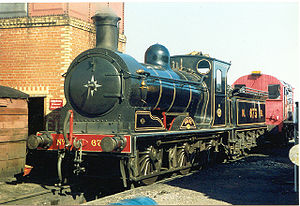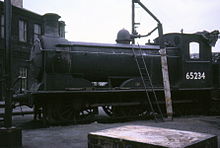- NBR C Class
-
NBR C Class
LNER Class J36
Preserved 673 Maude in NBR livery.
She represented Scotland at the Rainhill Trials 150th anniversary cavalcade in May 1980, hauling a Caledonian Railway coach.Power type Steam Designer Matthew Holmes Builder NBR Cowlairs Works (138),
Neilson & Co. (15),
Sharp, Stewart & Co. (15)Build date 1888 Total produced 168 Configuration 0-6-0 Gauge 4 ft 8 1⁄2 in (1,435 mm) Driver diameter 5 ft 0 in (1.524 m) Axle load 15 tons 15 cwt (35,300 lb or 16.0 t) Locomotive weight 41 tons 19 cwt (94,000 lb or 42.6 t) Tender weight 33 tons 9 cwt (74,900 lb or 34.0 t) Fuel type Coal Boiler pressure 165 lbf/in² (1.14 MPa) Cylinders Two, inside Cylinder size 18 × 26 in (457 × 660 mm) Valve gear Stephenson Tractive effort 19,690 lbf (87.59 kN) Power class BR: 2F Withdrawn 1926–1967 The NBR C Class (LNER Class J36) is a class of 0-6-0 steam locomotive designed by Matthew Holmes for freight work on the North British Railway. They were introduced in 1888 and had inside cylinders and Stephenson valve gear.
168 locomotives were built of which 123 came into British Railways ownership at nationalisation in 1948. This was the last class of steam engine in service in Scotland
Contents
NBR
After the introduction of the Drummond Class C (LNER Class J32) 18-inch (cylinder diameter) 0-6-0s, essentially for the Waverley Route in 1876, the NBR reverted to the 17-inch design with the Drummond Class D (J34) in 1879 and the Holmes Class D (J33) in 1883. With the opening of the second Tay Bridge in July 1887 and the upcoming opening of the Forth Bridge in March 1890 the NBR needed more powerful goods locos. The result was the Holmes Class C (J36). Introduced in 1888 it was built in regular batches until 1900, eventually totalling 168 locos. 138 were built at the NBR's Cowlairs Works while the other 30 were split equally between Neilson and Company and Sharp, Stewart and Company.
As built they had a saturated (non-superheated) boiler at 140 lbf/in²/0.97 MPa (150 lbf/in²/1.03 MPa for the last 24)[1] and Stephenson valve gear with slide valves.
From 1913 until 1923 the class was rebuilt with bigger boilers set at 165 psi and the Reid side-window cab.
During the First World War 25 of the class were sent to France for service with the Railway Operating Division. On return to Scotland they were given names of battles, generals and a cartoon soldier in recognition of their service. The names were hand-painted on the splasher above the middle driving wheel so often disappeared during repaints.
LNER
On January 1, 1923 all 168 locos passed into the hands of the LNER and became Class J36. As with all ex-NBR locos they had 9000 added to their number.
The final 8 unrebuilt locos were rebuilt in 1923.
In 1937 locomotives 9714 and 9716 (later 5285 and 5287)[2] were rebuilt with cutdown chimney and dome for use on the Gartverrie Branch.
In 1946 the remaining locos were renumbered from 5210 to 5346.
A number of locos had tender cabs fitted for use with snow ploughs.
BR
On 1 January 1948 at nationalisation, 123 locos passed into the hands of British Railways and had 60000 added to their number. On 5 June 1967 65288 of Dunfermline (62C) and 65345 of Thornton (62A) were withdrawn. They were the last steam locomotives in service in Scotland.
Locomotive names
NBR
NumberLNER 1946 Number BR Number Name 176 5217 65217 French 605 St Quentin 608 Foch 611 5268 65268 Allenby 612 5269 Ypres 615 Verdun 620 Rawlinson 621 Monro 627 Petain 628 5216 65216 Byng 631 Aisne 643 Arras 646 5222 65222 Somme 647 5223 Albert 648 5224 65224 Mons 650 5226 65226 Haig 657 5233 65233 Plumer 659 5235 65235 Gough 660 5236 65236 Horne 661 Ole Bill 662 Birdwood 666 Marne 673 5243 65243 Maude 676 Reims 682 5253 65253 Joffre Preservation
One, 673 Maude (LNER number 9673; LNER 1946 number 5243; BR number 65243) has been preserved by the Scottish Railway Preservation Society at the Bo'ness and Kinneil Railway.
Trivia
65288 was adopted by Dunfermline High School Railway Society and was repainted by society members while still in BR service [2]. It was fitted with one small and one normal sized buffer at the front end.
References
- ^ Marsden, Richard. "The Holmes J36 (NBR Class C) 0-6-0 Locomotives". LNER encyclopedia. http://www.lner.info/locos/J/j36.shtml.
- ^ [1]
- Ian Allan ABC of British Railways Locomotives, 1962 edition
- Casserley, H.C. & Johnston, Stuart W. (1974) [1966]. Locomotives at the Grouping 2: London & North Eastern Railway. Shepperton, Surrey: Ian Allan Limited. p. 56. ISBN 0-7110-0553-2.
- Aves, William A. T. (2009). The Railway Operating Division on the Western Front. Donnington: Shaun Tyas. pp. 147, 159. ISBN 978-1-900289-99-3.
External links
- Railuk database entry for J36
- Scottish Railway Preservation Society page on Maude
- Preserved locomotive database entry for Maude
London and North Eastern Railway locomotives Pre-grouping railway designs: D38 • D39 • D40 • D41 • D42 • D43 • D44 • D45 • D46 • D47 • D48 • G10 • J90 • J91 • Z4 • Z5A2 • A6 • A7 • B13 • B14 • B15 • B16 • C6 • C7 • C8 • D17/1 • D17/2 • D18 • D19 • D20 • D21 • D22 • D23 • E5 • E6 • F8 • G5 • G6 • H1 • J21 • J22 • J24 • J25 • J26 • J27 • J71 • J72 • J73 • J74 • J76 • J77 • J78 • J79 • N8 • N9 • N10 • Q5 • Q6 • Q7 • T1 • X1 • X2 • X3 • Y7 • Y8 • EB1 • EE1 • EF1 • ES1D24 • J23 • J28 • J75 • J80 • N11 • N12 • N13 • Q10LNER designs: Gresley (1923–1941):Thompson (1941–1946):Peppercorn (1946–1947):Other designs: Categories:- North British Railway locomotives
- 0-6-0 locomotives
- Neilson locomotives
- Sharp Stewart locomotives
- Railway locomotives introduced in 1888
- Railway Operating Division locomotives
Wikimedia Foundation. 2010.

